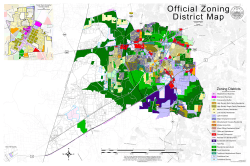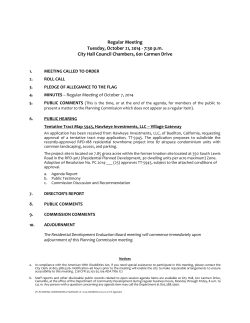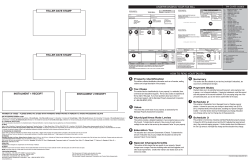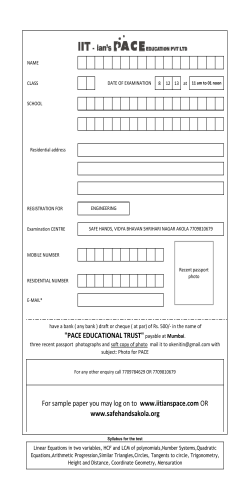
12/16/14, 7:45 p.m.: FY15 Classification Tax Allocation
OFFICE OF THE TOWN COUNCIL William Wood District 6 President 1656 Dr. Kevin Perry District 4 Sheila Whitaker At Large Timothy Fitzgibbons District 2 Scott Pitta District 1 Sandra Wright District 3 Peter Colombotos District 5 Memorial Building, 25 South Street Bridgewater, MA 02324 John Norris District 7 William Rivers At Large TOWN OF BRIDGEWATER TOWN COUNCIL PUBLIC HEARING NOTICE Pursuant to the provisions of Chapter 40, Section 56, of the Massachusetts General Laws, as amended, on Tuesday, December 16, 2014 at 7:45 p.m., the Town Council will conduct a public hearing at their meeting to be held at BTV Studios, 80 Spring Street, Bridgewater, MA to hold the Annual Property Tax Classification, specifically the issue of allocating the local property tax levy among the four classes (Residential, Open Space, Commercial and Industrial) of real property and personal property for FY2015. Interested parties are invited to be present and to be heard. Oral and written testimony will be accepted at the meeting. Town Council www.bridgewaterma.org Bridgewater Town Council In Town Council, Tuesday, December 16, 2014 Order #O‐2014‐026 Introduced By: Town Manager (at the request of the Assessor’s Office) Date Introduced: November 18, 2014 First Reading: November 18, 2014 Second Reading/Public Hearing: December 16, 2014 Third Reading: Amendments Adopted: Date Adopted: Date Effective: Order# O‐2014‐026: FY 2015 Classification Tax Allocation‐Adoption of Residential Factor ORDERED that, pursuant to G.L. c. 40, § 56, the Town Council of the Town of Bridgewater, Massachusetts in Town Council assembled vote to adopt a residential factor of 1 for fiscal year 2015. Explanation: The town council shall annually first determine the percentages of the local tax levy to be borne by each class of real property, as defined in section two A of chapter fifty‐nine and personal property for the next fiscal year. In determining such percentages, the town council, shall first adopt a residential factor. Said factor shall be an amount not less than the minimum residential factor determined by the commissioner of revenue in accordance with the provisions of section one A of chapter fifty‐eight and shall be used by the board of assessors to determine the percentages of the local tax levy to be borne by each class of real and personal property. Committee Referrals and Dispositions: • • • • Referral(s) Council’s Budget & Finance Committee Finance Committee Requires advertising and a public hearing. This measure may be finally considered this evening at the closing of the hearing. Disposition(s) • 12/2/14: vote 3-0 recommend approval • 12/1/14: vote 6-0 approve • This measure was advertised in the Enterprise on 12/1/14 for a public hearing. ROLL CALL VOTE: REQUIRES MAJORITY VOTE OF FULL COUNCIL (5) Town of Bridgewater Classification Presentation and Selection of Minimum Residential Factor for Fiscal Year 2015 Presented by the Bridgewater Board of Assessors Marjorie Callaghan, Chairman Donna Barakauskas, Clerk Shelley McCauley, MAA Assistant Assessor 1 Introduction The information contained in this report is intended to provide the Town Council with information necessary to conduct a public hearing on the classification options available under Massachusetts General Law. The classification process allows the council to consider several options that will be explained further along in this handout. Additionally, the decision of the Town Council for each of the options must be submitted to the Department of Revenue on form LA 5. Further attached are some additional exhibits A‐F which may be helpful. Classification Hearing Before the tax rate can be set, the Town Council must hold a public hearing each year to consider the tax rate options available to the municipality under property tax classification. These tax levy‐shifting tools will not change the overall tax levy or money that will be raised through property taxes; rather they allow the town to shift portions of the tax levy between classes of property and/or between property owners within certain property classes. The hearing is held after the assessors have determined final values and classified all properties and reported this information to the DOR. These values set the parameters for the options the municipality may adopt. This public hearing, shall comply with the requirements of the “Open Meeting Law”, and any local charter, by‐law or ordinance provisions. In addition, local officials must provide notice of the hearing to all taxpayers by a comprehensive public information release in a newspaper of general circulation in the community, as well as in any other appropriate news media. This release should provide information regarding the policy decisions available, and should indicate the manner by which interested taxpayers may present oral or written information on their views. When providing notice and when conducting the public hearing, local officials shall further the legislative intent to provide an open forum for the discussion of local property tax policy. The assessors provide the council with the information necessary to make classifications decisions. This information should show the impact on the tax rate of the available tax policy options. The assessors are not required to make recommendations, although they may choose to do so if asked. The Town Council conducts the classification hearing and vote on the available tax rate options. The vote may be taken at the hearing or a later meeting. 2 TAX POLICY DECISIONS Municipalities have several options in distributing the tax levy among taxpayers under property tax classification. Use of these options results in multiple tax rates for different property classes because they change the components used to calculate the rate, i.e., the assessed valuation of or the amount of the tax levy being paid, by the class. The total tax levy remains the same. Single or Split Tax Rate Municipalities must decide whether to: 1. Tax all classes of property at their full and fair cash valuation share of the tax levy, which results in a single tax rate 2. Reduce the share of the tax levy paid by the residential and open space property owners and shift those taxes to commercial, industrial and personal property taxpayers, which results in a split tax rate. Classification Exemption Options Municipalities may also consider whether to allow: 1. An open space discount 2. A residential exemption 3. A small commercial exemption Selection of a residential factor: Town council must decide the percentages of the tax levy each class of real property and personal property will bear each year. To do so a residential factor is adopted. The residential factor governs the percentage of the tax levy to be paid by Class One: Residential and Class Two: Open Space properties. The difference is shifted to Class Three: Commercial, Class Four: Industrial and Personal properties. The adopted factor cannot be less than the minimum residential factor (MRF) calculated by the DOR. The MRF represents the maximum shift allowed in the tax levy for the year and establishes the parameters for local decision‐making. The residential factor commonly referred to as the “Split Tax Rate” allows the Town Council to adopt different residential factors which ultimately determines the tax rates: one for residential property owners and one for commercial, industrial and personal property owners. If a factor of “1” was adopted, the tax rate would be the same for all classes ($16.24). This rate is determined by dividing the tax levy by the total value of all taxable property in Bridgewater and then multiplying that result by 1000. Levy: 38,472,471/ Value: 2,368,994,490 = (0.01624) x 1000 = Tax Rate $16.24 The Board of Assessors recommends to vote to adopt a residential factor of 1 for fiscal year 2015. 3 The table below summarizes the tax rate impact at various shift intervals. CIP RESIDENTIAL RESIDENTIAL CIP RESIDENTIAL SHIFT FACTOR % % TAX RATE 1 1.00 85.8723 14.1277 16.24 1.10 98.3548 84.4596 15.5404 15.97 1.25 95.8870 82.3404 17.6596 15.57 1.50 91.7740 78.8085 21.1915 14.90 (Bold print represents the maximum allowable shift capacity) CIP TAX RATE 16.24 17.86 20.30 24.36 It is important to note that although the council is effectively choosing the CIP shift factor, it is technically selecting the Residential Factor in column two that is the result of selecting the CIP shift illustrated in the first column. The next two columns indicate the respective share of the tax burden resulting from the corresponding shift factor. The final two columns present the anticipated tax rates for each class. For your information, the average single family home value for fiscal year 2015 is $310,417. In consideration of that value, the table below summarized the anticipated FY 2015 average tax bill amounts at various shift intervals. CIP SHIFT 1 1.10 1.25 1.50 RESIDENTIAL RESIDENTIAL RESIDENTIAL TAX EST. FY15 FACTOR PERCENTAGE RATE TAX BILL 1.00 5,041 85.8723 16.24 98.3548 4,957 84.4596 15.97 95.8870 82.3404 15.57 4,833 91.7740 78.8085 14.90 4,625 (Bold print represents the maximum allowable shift available for FY2015) Shift in Tax Dollars ‐$84.00 ‐$208.00 ‐$416.00 Additionally, the average commercial valuation for fiscal year 2015 is $613,682. The table below summarizes the anticipated FY2015 average tax bill amounts. CIP SHIFT EST. FY15 RESIDENTIAL CIP CIP TAX BILL PERCENTAGE TAX RATE FACTOR 1 1.00 9,966 14.1277 16.24 1.10 98.4753 10,960 15.5404 17.86 95.8870 17.6596 20.30 1.25 12,458 91.7740 21.1915 24.36 1.50 14,949 (Bold print represents the maximum allowable shift available for FY2015) 4 Shift in Tax Dollars $994.00 $2,492.00 $4,983.00 Classification Options Residential Factor of “1” (Single Tax Rate) CLASS Residential Open Space Commercial Industrial Personal Prop Total VALUE PERCENTAGE 2,034,310,900 85.8723% R & O % 0 0.0000% 85.8723% 177,749,900 7.5032% 69,625,820 2.9390% CIP % 87,307,870 2,368,994,490 3.6854% 14.1277% 100.0000% CLASSIFICATION OPTIONS 0 Residential Exempt 0 Small Commercial Exemption LEVY 38,472,471 Estimated Levy 16.24 Single Tax Rate What If ... Scenario Worksheet CIP Shift Res Factor Share Percentages Levy Amounts Res O S Com Ind PP Total Estimated Tax Rates Res O S Com Ind PP Total Res O S Com Ind PP 1 100 85.8723 0 7.5032 2.9390 3.6854 100 33,037,209 0 2,886,658 1,130,723 1,417,880 38,472,471 16.24 0 16.24 16.24 16.24 1.05 99.1774 85.1660 0 7.8783 3.0860 3.8697 100 32,765,446 0 3,030,991 1,187,259 1,488,774 38,472,471 16.11 0 17.05 17.05 17.05 1.10 98.3548 84.4596 0 8.2535 3.2329 4.0540 100 32,493,683 0 3,175,324 1,243,796 1,559,668 38,472,471 15.97 0 17.86 17.86 17.86 1.15 97.5322 83.7532 0 8.6287 3.3799 4.2383 100 32,221,920 0 3,319,657 1,300,332 1,630,562 38,472,471 15.84 0 18.68 18.68 18.68 1.20 96.7096 83.0468 0 9.0038 3.5269 4.4225 100 31,950,157 0 3,463,990 1,356,868 1,701,456 38,472,471 15.71 0 19.49 19.49 19.49 1.25 95.8870 82.3404 0 9.3790 3.6738 4.6068 100 31,678,394 0 3,608,323 1,413,404 1,772,350 38,472,471 15.57 0 20.3 20.3 20.3 1.30 95.0644 81.6340 0 9.7541 3.8208 4.7911 100 31,406,631 0 3,752,656 1,469,940 1,843,244 38,472,471 15.44 0 21.11 21.11 21.11 1.35 94.2418 80.9277 0 10.1293 3.9677 4.9753 100 31,134,868 0 3,896,989 1,526,476 1,914,138 38,472,471 15.30 0 21.92 21.92 21.92 1.40 93.4192 80.2213 0 10.5045 4.1147 5.1596 100 30,863,105 0 4,041,322 1,583,013 1,985,032 38,472,471 15.17 0 22.74 22.74 22.74 1.45 92.5966 79.5149 0 10.8796 4.2616 5.3439 100 30,591,342 0 4,185,655 1,639,549 2,055,926 38,472,471 15.04 0 23.55 23.55 23.55 1.50 91.7740 78.8085 0 11.2548 4.4086 5.5282 100 30,319,579 0 4,329,988 1,696,085 2,126,820 38,472,471 14.90 0 24.36 24.36 24.36 5 6 EXHIBIT B FISCAL YEAR 2014TAX RATES FOR THE TOWN OF BRIDGEWATER AND NEIGHBORING COMMUNITIES RESIDENTIAL TAX RATE BRIDGEWATER $16.25 E BRIDGWATER $17.37 HALIFAX $18.67 MIDDLEBOROUGH $15.60 RAYNHAM $15.42 $16.49 W BRIDGEWATER COMMUNITY CIP AVG SF RES TAX RATE TAX BILL $16.25 $4,910 $17.37 $5,119 $18.67 $5,010 $16.59 $3,972 $21.63 $4,534 $26.57 $4,618 FISCAL YEAR 2014 TAX SHIFT FOR THE TOWN OF BRIDGEWATER AND NEIGHBORING COMMUNITIES COMMUNITY MAXIMUM ALLOWABLE SHIFT BRIDGEWATER E BRIDGEWATER HALIFAX MIDDLEBOROUGH RAYNHAM W BRIDGEWATER 1.50 1.50 1.50 1.50 1.50 1.50 7 FISCAL YEAR 2014 ACTUAL SHIFT 1.00 1.00 1.00 1.05 1.26 1.35 % OF LEVY RES. 86.77 88.33 89.09 78.66 64.62 57.25 %OF LEVY CIP 13.23 11.67 10.91 21.34 35.38 42.75 FISCAL YEAR 2015 TAX RATES FOR THE TOWN OF BRIDGEWATER AND NEIGHBORING COMMUNITIES RESIDENTIAL TAX RATE BRIDGEWATER $16.24 E BRIDGWATER $17.76 HALIFAX $18.99 MIDDLEBOROUGH $15.78 RAYNHAM $15.24(Est) W BRIDGEWATER $17.81 COMMUNITY CIP AVG SF RES TAX RATE TAX BILL $16.24 $5,041 $17.76 $5,315 $18.99 $5,218 $16.77 $4,126 $21.59(Est) $4,721(Est) $28.78 $5,089 FISCAL YEAR 2015 TAX SHIFT FOR THE TOWN OF BRIDGEWATER AND NEIGHBORING COMMUNITIES COMMUNITY MAXIMUM ALLOWABLE SHIFT BRIDGEWATER E BRIDGEWATER HALIFAX MIDDLEBOROUGH RAYNHAM W BRIDGEWATER 1.50 1.50 1.50 1.50 1.50 1.50 1.35 8 FISCAL YEAR 2014 ACTUAL SHIFT 1.00 1.00 1.00 1.05 % OF LEVY RES. %OF LEVY CIP 85.87 88.50 89.37 79.41 14.13 11.50 10.63 20.59 56.85 43.15 EXHIBIT C TERM Levy DEFINITION The property tax levy is the revenue a community can raise through real and personal property taxes. Levy Limit The maximum a community can levy in a given year equal to last year’s levy plus 2.5% plus new growth plus override / exclusion if applicable. Levy Ceiling Equal to 2.5% of the total full and fair cash value of all taxable real and personal property in the community. New Growth Increase in the tax base due to new construction, parcel subdivisions, condominium conversions and property renovations but not due to revaluation. It is calculated by multiplying the increased assessed valuation by the prior year’s tax rate for the appropriate class of property. Override A permanent increase to a community’s levy limit. Override Capacity The difference between a community’s levy ceiling and its levy limit. It is the maximum amount by which a community may override its levy limit. Debt Exclusion A temporary increase over the levy limit for the payment of a specific debt service item over a specific period of time. A temporary exclusion for the purpose of raising funds Capital for capital project costs. Outlay Expenditure Excess Levy The difference between the actual levy and the levy limit. Capacity 9 EXHIBIT D Frequently Asked Questions 1. What is the levy limit? The levy limit is the maximum amount a community can raise through property taxes in any given year. The levy limit is based on the previous year's limit plus allowable increases. These allowable increases include the annual 2½ percent increase, new growth and overrides. The levy limit will always be below or at most equal to, the levy ceiling of 2½ percent of the total full and fair cash value of the community's taxable real and personal property. A community may also levy above the levy limit or ceiling through an exclusion. 2. What is the difference between an override and a debt exclusion or capital outlay exclusion? An override is a voted increase in the levy limit. An override cannot increase a community's levy limit above the community's levy ceiling. The levy ceiling is equal to 2½ percent of the full and fair cash value of all taxable property in the community. When an override is passed the levy limit for the year is calculated by including the amount of the override. The override results in a permanent increase in the levy limit of the community. Overrides require a majority vote of approval by the electorate. A community can also assess taxes in excess of its levy limit or levy ceiling for the payment of certain capital projects and for the payment of specified debt service costs called exclusions. An exclusion for the purpose of raising funds for debt service costs is referred to as a debt exclusion, and an exclusion for the purpose of raising funds for capital project costs is referred to as a capital outlay expenditure exclusion. Both exclusions require voter approval with very limited exceptions. Unlike overrides, exclusions do not become part of the base upon which the levy limit is calculated for future years. 3.What is an Underride? Proposition 21⁄2 allows a community to reduce its levy limit by passing an underride. When an underride is passed, the levy limit for the year is calculated by subtracting the amount of the underride. The underride results in a permanent decrease in the levy limit of a community because it reduces the base upon which levy limits are calculated for future years. A majority vote of a community’s selectmen, or town or city council (with the mayor’s approval if required by law) allows an underride question to be placed on the ballot. An underride question may also be placed on the ballot by the people using a local initiative procedure, if one is provided by law. Underride questions must state a dollar amount and require a majority vote of approval by the electorate. 4. What determines a community's tax rate? A tax rate is set after three important factors are determined: the community's levy limit, the amount needed to be raised by taxation, and property assessments reflecting full and fair market value are finalized. The actual rate formula is the total levy divided by the total property value multiplied by 1,000. 10 5. When and why do tax rates increase? Tax Rates can increase when (1) there is an increase in the actual amount needed to be raised by taxes, (2) property assessments decrease (market values decline), (3) overrides or exclusions are passed, (4) new growth is added, (5) unused levy capacity from the previous year is used in the current year, (6) decreases are made in the prior year tax base through the abatement process. 6. Why is setting a timely tax rate important? Until a tax rate is "set" or finalized, the community cannot send an actual property tax bill. By setting a timely tax rate the municipality can generate timely bills and improve the cash flow in the community. Also, if the community does not send out tax bills in a timely fashion, it can jeopardize its cash flow position. It may be forced to borrow, resulting in unnecessary debt service. If it bills semiannually and elects to send out an estimated preliminary bill, there are extra expenses generated from such bill processing. 7. Why and when do we hold a classification hearing? A classification hearing is held annually to determine whether to shift some of the property tax burden from one class of property to another. A public hearing is called by the Town Council. It must be held after the assessors have finalized assessments for the year and before the tax rate can be set. Options presented include reallocating some of the tax obligation (l) from the Residential and Open Space classes to the Commercial, Industrial, Personal Property classes; (2) from Open Space to Residential; (3) within the Residential class, to non‐domiciled owners, and (4) within the Commercial and Industrial classes, to more expensive properties with larger commercial businesses. Adopting one or more of these choices results in multiple tax rate(s) for the community. 8. Do the values have to be final before holding a classification hearing? The Assessors must have finalized all assessments for the fiscal year before the Town Council can vote on allocating the tax burden. This is required so that the minimum and maximum allowable shifts can be accurately calculated and the implication of the vote can be considered. 9. What does it mean to have a split tax rate? All taxable property is categorized by the assessors into one of five classes according to use. These are: Residential (R), Open Space (O), Commercial (C), Industrial (I), Personal Property (P). The term “split” tax rate usually is used to refer to having two tax rates that shift some of the tax burden from Residential and Open Space to Commercial, Industrial and Personal Property classes. Under a single tax rate system, if residential and open space property assessments are 80% of total value, then 80% of tax levy would come from the R and O classes (and 20% from the CIP). By “splitting” the tax rate, the law allows a city or town to increase the levy share raised from the CIP as much as 50% in order to reduce the tax burden on R and O. In this example then, the maximum shift allowed would result in 30% of the taxes being paid by the CIP classes, and 70% by R and O. 10. How does a municipality determine the amounts to be budgeted for the overlay and estimated receipts on the Tax Recap? The Assessors are responsible for determining the amount to be budgeted on the Tax Recap for the overlay. The amount of estimated receipts is determined by the official(s) responsible for estimating receipts for budget purposes. Both amounts should be set with a great deal of 11 input from the other members of the financial team. The overlay is an amount raised to cover abatements and exemptions granted by the assessors. An overlay worksheet, the OL‐1, must accompany the tax recap submission. This form summarizes a 3‐year history of this account. A reasonable projection for next year can be based on this information. Additional issues to be addressed include such factors as changes in laws governing abatements and exemptions, changes in demographics, in the economy, in assessment systems, as well as the stability of real estate values. Money in the overlay account that is not/will not be needed may be declared surplus. Estimated receipts projections are usually based on the previous year's actual revenues as certified by the accountant. To this information is added the financial team’s knowledge of relevant changes which may occur in the next year, such as one‐time settlements, a change in fee structures, the rescheduling of data releases from the registry of motor vehicles, etc. 11. What are "other amounts to be raised"? These are amounts that must be raised on the tax rate recap to fund expenditures that can be made without appropriation or to cover deficits. They are listed on page two of the recap and include debt service payments, final court judgments, snow and ice removal deficits, state and county charges, Cherry Sheet offset items, overlay allowance for abatement and exemptions, prior years’ overlay deficits and revenue deficits. 12. If we do not levy to the limit do we lose that levy capacity? No. If a community chooses not to levy to its capacity in one year, it does not lose the capacity to levy to the limit in future years. Before the tax rate is set, the full amount of the levy limit is always available to the community, regardless of how much it chose to use in previous years. Proposition 2½ allows a community to have excess levy capacity in one year (i.e., not levy to its limit) and in the following year, to levy right up to the full amount of its new limit. This increase results in an overall levy increase greater than 2½ percent. 13. How is the average single‐family residential tax bill calculated? First, sum the assessed value of all the single‐family property parcels in the municipality. Second, divide the result by the number of single‐family parcels to obtain the average single family value. Finally, multiply the average single‐family value by the residential tax rate and divide the result by 1,000 to obtain the average single‐family tax bill. 14. Why did my tax bill go up more than 2½ percent? Once a community's levy limit has been established, the community then decides how much money to raise through taxation. Because Proposition 2½ regulates the levy limit rather than the actual amount levied, taxpayers' bills may increase more than 2½ percent in a given year. These increases often occur when in one year the community decides not to levy to its limit and then in the following year levies right up to its limit. Also, new growth, voted overrides and exclusions can all increase the amount levied. In addition, an individual tax bill may increase more than 2½ percent as a result of property revaluation. This increase may reflect an increased assessment due to new construction or a change in the real estate market that results in some properties increasing in value while others decrease. 12 EXHIBIT E CLASSIFICATION CONSIDERATIONS SOME ECONOMIC & POLITICAL ISSUES Consider the percentage of Commercial & Industrial (C & I) properties as compared to Residential (R) Will an increased tax burden on C & I significantly lower the R tax burden? What is the mix of C & I properties? How much is big business? How much is small business (mom & pop)? Are the businesses of the type that require extraordinary municipal services? Will it adversely affect small businesses & drive them out of the community? Would a small commercial exemption help? Will it slow big business development? Does business significantly contribute in a non‐tax way to the community? Is the timing proper for the move to a multiple or single tax rate? Will a shift to the C & I maintain or increase the relative or historical share of the tax burden? Is it a matter of principle or economics? 13 EXHIBIT F Fiscal Year 2000-2014 Assessed Values by Class (1) FY 2000 2001 2002 2003 2004 2005 2006 2007 2008 2009 2010 2011 2012 2013 2014 Residential 1,090,160,500 1,120,659,400 1,139,056,300 1,719,516,968 1,742,198,823 2,156,061,454 2,468,339,839 2,510,492,784 2,441,020,387 2,313,353,326 2,147,538,115 2,052,517,912 2,009,484,573 1,969,013,554 1,972,183,142 (2) Open Space (3) (4) (5) Commercial 70,827,000 73,330,100 78,616,100 102,274,632 106,025,177 109,806,966 141,477,371 143,423,216 145,547,923 169,143,214 166,446,655 161,736,288 160,983,127 169,266,776 173,107,868 Industrial 33,633,200 35,272,900 36,067,800 43,588,000 43,490,400 44,678,500 63,144,100 65,632,700 64,580,500 71,301,600 68,650,400 67,150,600 71,533,720 69,297,020 69,981,520 Personal Property 28,527,800 30,740,400 36,158,500 40,319,500 42,871,760 43,449,480 52,458,870 49,229,650 52,940,450 62,870,630 63,032,010 60,063,170 61,579,020 61,643,120 57,617,110 Total 1,223,148,500 1,260,002,800 1,289,898,700 1,905,699,100 1,934,586,160 2,353,996,400 2,725,420,180 2,768,778,350 2,704,089,260 2,616,668,770 2,445,667,180 2,341,467,970 2,303,580,440 2,269,220,470 2,272,889,910 R&O (1 - 2) % of Total 89.1 88.9 88.3 90.2 90.1 91.6 90.6 90.7 90.3 88.4 87.8 87.7 87.2 86.7 86.7 CIP (3 - 5) % of Total 10.9 11.1 11.7 9.8 9.9 8.4 9.4 9.3 9.7 11.6 12.2 12.3 12.8 13.3 13.3 Fiscal Year 2000-2014 Average Single Family Tax Bill FY 2000 2001 2002 2003 2004 2005 2006 2007 2008 2009 2010 2011 2012 2013 2014 Assessed Value 863,113,000 897,750,200 918,590,600 1,369,676,900 1,393,223,100 1,727,615,300 1,992,394,900 2,021,569,100 1,956,207,000 1,836,718,200 1,705,063,200 1,634,016,200 1,611,935.000 1,581,040,800 1,585,938,800 Parcels 4,655 4,782 4,868 4,960 5,002 5,043 5,113 5,145 5,186 5,187 5,204 5,209 5,223 5,235 5,249 Average Value 185,416 187,735 188,700 276,145 278,533 342,577 389,672 392,919 377,209 354,100 327,645 313,691 308,622 302,014 302,141 14 Tax Rate 14.03 14.46 15.18 10.99 11.33 9.76 9.11 9.60 10.35 11.34 12.31 14.42 15.11 15.83 16.25 Single Family Tax Bill 2,601 2,715 2,864 3,035 3,156 3,344 3,550 3,772 3,904 4,015 4,033 4,523 4,663 4,781 4,910 Hi-Lo Rank 124 124 130 133 147 141 139 132 129 130 144 110 115 116 119 % Value Change 17.51% 1.25% 0.51% 46.34% 0.86% 22.99% 13.75% 0.83% -4.00% -6.13% -7.47% -4.26% -1.62% -2.14% .04% Neither the Town Council nor the Town Manager requested the information below. The classification exemption options are for informational purposes only and data is from fiscal year 2011. Adoption of an Open Space Discount: Massachusetts General Law, Chapter 59, section 2A defines class 2 open space as: “Land which is not otherwise classified and which is not taxable under the provisions of Chapter 61, 61A or 61B, or taxable under a permanent conservation restriction, and which land is not held for the production of income but is maintained in an open or natural condition and which contributes significantly to the benefit and enjoyment of the public”. The council may allow for a discount for all Class Two, Open Space properties. A maximum exemption of 25% may be adopted for all property that is classified as Open Space. The Board of Assessors has determined that no property in the Town of Bridgewater meets the strict definition of Open Space and therefore there are no properties in this class. Adoption of Residential Exemption: A decision to adopt the provisions of a residential exemption is made by the policy making board of the municipality. The residential exemption is a local option authorized by M.G.L. Ch.59 ss.5C which allows a community to shift the tax burden from certain lower valued, residential properties to higher valued homes, most apartment buildings and to second home owners. To qualify for a residential exemption a property must be, on January 1, the owner‐ occupied, primary residence used by the taxpayer for income tax purposes. The exemption works as a decrease in the assessed value of a qualifying property in an amount not to exceed 20% of the average assessed value of all Class One: Residential properties. The exemption reduces, by the adopted percentage, the taxable valuation of each residential parcel that is a taxpayer’s principle residence. Adopting the residential exemption increases the residential tax rate. The amount of the tax levy paid by the class remains the same, but because of the exempted valuation, it is distributed over less assessed value. 15 Below are two residential exemption estimators using an exemption percentage of ten and twenty percent. These estimates are based on fiscal year 2011 data extracted from the Division of Local Services Gateway Database. Exemption Percentage 10% Estimated percent owner occupied As of 1/1/2010 Property Type Single family Condos Multi-family (2 & 3 family) Apartments Misc % Owneroccupied 95.0% 95.0% 35.0% 15.0% 35.0% Tax Rate without Residential Exemption 14.42 Value of owneroccupied home $30,000.00 $110,000.00 $160,000.00 $210,000.00 $260,000.00 $309,797.47 $360,000.00 $410,000.00 $460,000.00 $510,000.00 $560,000.00 $610,000.00 Tax Rate with Residential Exemption 15.83 Tax bill w/o exemption Bridgewater Fiscal Year 2011 Tax bill with exemption $432.60 $1,586.20 $2,307.20 $3,028.20 $3,749.20 $4,467.28 $5,191.20 $5,912.20 $6,633.20 $7,354.20 $8,075.20 $8,796.20 $38.09 $1,304.49 $2,095.99 $2,887.49 $3,678.99 $4,467.28 $5,261.99 $6,053.49 $6,844.99 $7,636.49 $8,427.99 $9,219.49 Change in tax bill* ($394.51) ($281.71) ($211.21) ($140.71) ($70.21) $0.00 $70.79 $141.29 $211.79 $282.29 $352.79 $423.29 Amounts in parentheses represent decrease in tax bills 16 Exemption Percentage 20% Tax Rate without Residential Exemption 14.42 Value of owneroccupied home $60,000.00 $160,000.00 $200,000.00 $240,000.00 $280,000.00 $326,796.89 $370,000.00 $410,000.00 $450,000.00 $490,000.00 $530,000.00 $570,000.00 Tax Rate with Residential Exemption 17.35 Tax bill w/o exemption Bridgewater Fiscal Year 2011 Tax bill with exemption $865.20 $2,307.20 $2,884.00 $3,460.80 $4,037.60 $4,712.41 $5,335.40 $5,912.20 $6,489.00 $7,065.80 $7,642.60 $8,219.40 $83.49 $1,818.49 $2,512.49 $3,206.49 $3,900.49 $4,712.41 $5,461.99 $6,155.99 $6,849.99 $7,543.99 $8,237.99 $8,931.99 Change in tax bill* ($781.71) ($488.71) ($371.51) ($254.31) ($137.11) $0.00 $126.59 $243.79 $360.99 $478.19 $595.39 $712.59 Amounts in parentheses represent decrease in tax bills Only fourteen of the 351 communities in Massachusetts currently use the residential exemption and they tend to be communities with a large number of apartment buildings (Boston, Brookline, Cambridge and Chelsea ) or a large number of second homes (Tisbury and Nantucket). This exemption is typically attractive to resort communities, or to those with a high proportion of rental units, absentee landlords and second home owners. In effect, the exemption shifts a portion of the tax burden, within the residential class, away from lower valued single family homes to higher valued homes, multi‐family properties, apartment buildings and non‐resident property owners. 17 Adoption of the small commercial exemption: The Town Council may grant a small commercial exemption (G.L. Ch.59 ss5I) to all Class Three: Commercial properties (not Industrial) of up to 10% of the property valuation who meet the requirements set forth under the law. To receive a small commercial exemption the parcel must be occupied as of January 1 by a business with an average annual employment of no more than ten people during the previous year as certified by the Director of the Department of Labor and Workforce Development and assessed valuation of less than $1,000,000. Any small commercial exemption granted is borne by other Class Three: Commercial and Class Four: Industrial, real property, but not by personal property. The tax levy to be raised from commercial and industrial properties remains the same. Use of the reduced valuation in setting the tax rate results in a higher tax rate for Commercial and Industrial classes than for personal property. If the total value of Commercial/Industrial was $1,000,000 and 10% of the commercial class was found to be partially exempted the remaining 90% would make up the difference. This does not help the residential taxpayer. The Board of Assessors has determined that there are approximately 20 eligible businesses and 15 that may be eligible according to the Department of Labor and Workforce Development. There may be additional eligible sole proprietorships and partnerships that do not appear on the list. However, the process of determining eligibility would be arduous. Last year only ten communities in the Commonwealth had adopted the small commercial exemption. The average commercial tax base in those communities was 26% and all but one had a split tax rate. 18
© Copyright 2025









